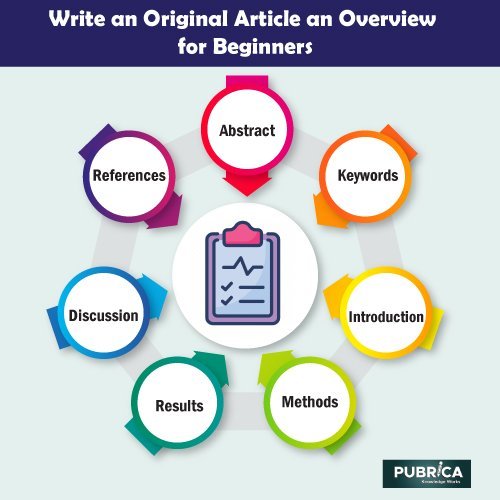
A guide to preparing case reports for the Journal of Medical Case Reports
February 2, 2022
Power relations in educational, scientific communication: a critical examination of learning style discourse
February 9, 2022In brief
Only around half of the abstracts at scientific conferences are turned into complete works. This text is a step-by-step guide to putting together a scientific study of an article. The Vancouver statement should be used to determine authorship criteria. The first stage is to describe the materials and procedures, including the statistical analysis (about 1,000 words), which should be completed during the investigation. The second stage represents the results without interpreting them (about 350 words); graphics are preferable to tables. The discussion (approximately 1,000-1,350 words) begins with a summary of the most significant findings, followed by a defence of the model used. A well-written original article explains what was done, why it was done, how it was done, the outcome of the work, and its relevance. Many papers fail to report their findings adequately.
Introduction
For researchers in any area, exposing the results of a study in an article for publishing in a scientific journal is a regular practice. Those who want to build a scientific career have traditionally been judged and known based on the effect of their study. However, they are not acknowledged as researchers until their findings are published. As a result, the goal of scientific research is to produce novel publications.
Evidence synthesis
Before starting writing
The literature search is the first step before writing and before beginning any original research manuscript writing activity. Prior evidence should be gathered, studied, and reflected upon as the beginning point and firm foundation for any publishing. If this stage is avoided, it is possible to make the error of completing a task that has already been finalized, resulting in a loss of time and resources. Similarly, before considering writing, a reflection and self-criticism exercise is required to determine whether future publishing should occur. To do so, you must first ask yourself a set of questions: Have I completed any new or exciting projects? Is the work relevant to contemporary events? Is there any concrete evidence? If the response to each question is ‘yes’, one may consider writing the article.
At this stage, the author should decide whether to write an original part, report a clinical case or series of cases, write a letter to the editor, or anything else. Each one has a clear goal in mind, and each one’s development takes a different path.
After the journal has been selected, it is critical to read the author’s guide, generally found on the journal’s website. It determines the article’s design and organization, the bibliographical style, the maximum amount of words, and the format of figures and tables, among other things. The article must satisfy all of the standards’ requirements. It is more probable that the article will be accepted if reviewers and editors do not waste time fixing these issues.

Preparation of the article
According to general principles, large portions should be prepared while producing an original piece. The first enables indexing and focusing on the topic and makes the content more valuable and appealing. The title, authors and affiliations, abstract, and keywords are all included in this section. The primary material, the original research paper writing itself, is covered in the second section, generally divided into the following areas: introduction, methods, results, and discussion (IMRAD). Acknowledgements, references, and supplemental information or annexes are included in the concluding section.
The home page must include: – The title: a good title resentment the reader’s interest and draws them into the content. However, its primary purpose is to summarise the manuscript’s substance correctly, and it should be as brief as feasible while explaining the study’s design. The title should include all of the details that make the article’s electronic retrieval sensitive and particular.
Abstract
To offer a picture of the substance and scope of the essay, the essential concepts and outcomes should be laid out. Because it is the only portion that many readers will read and the only part utilized in bibliographic search engines, it is critical to explain the most significant aspects of the work succinctly and explicitly. It’s finest to write the abstract after you’ve completed writing the text because that’s when you’ll know which points to emphasize.
Keywords
They should be carefully chosen to increase the article’s visibility and make it easier to find using automated search tools. The terminology provided in the National Library of Medicine’s Medical Subject Headings (MeSH) should be utilized.
Introduction
The introduction should set the quality for the work, revealing the nature and importance of the problem that prompted the study. It is impaired into three sections that answer the following questions: What is the issue? What is the problem’s significance, and what questions remain unanswered? What is the answer to the question that your work addresses? The hypothesis, as well as the work’s aims, should be explained in this section. The introduction should be straightforward and succinct, with just the absolute minimum of references.
Methods
This section explains how the study was carried out and should be comprehensive enough for another author to replicate it in whole or in part. It is written in the past and should only include information known at the research’s design, but the Results section should include all information gathered from the study.
Results
You should absolutely and entirely include the study’s findings. Comments on the significance of the results should be saved for the Discussion section.
Discussion
The importance of the work’s significance and relevance should be highlighted in this section. Don’t repeat what’s already been said in the Introduction and Results in areas. It is generally helpful to begin the conversation by quickly stating the study’s primary findings and then thinking out plausible interpretations for these findings and comparing them with other relevant research findings.
References
In general, the National Library of Medicine’s requirements should be followed, but it’s also essential to check the rules for writers of each publication to confirm the bibliography’s structure and style. The quotations are listed in the order in which they appear in the text. Only include references that add value to your content, and aim to keep them under five years old. Quote actual articles rather than review ones wherever feasible, and make sure the quote matches the original research article part you wish to mention.
Conclusions
It takes patience and, most importantly, practise to write an essay. The principles and suggestions listed above can help to speed up the procedure and avoid inflated errors. Nonetheless, it is necessary to conduct a thorough study before the scientific original research article has a unique part. If the performed research is substandard or contains methodological problems, no matter how well written, an original paper will not be published in a high-impact factor journal.
About Pubrica
Pubrica has worked as a medical writer in the earlier. Clinical Research, Pharmacology, Public Health, Regulatory Writing, Clinical Report Forms (Crf), Biostatistics, Psychology, Life Science, Dentistry, Radiology, Dermatology, Diabetology, Gynecology, Cardiology, Biochemistry, Forensics, Surgery, Neurology, Psychiatry, Genomics, Medical Device, Pharmaceutical, Nutraceutical, Fmcg Companies, Hospitals, Universities, Pubrica’s team of medical professionals offer unique medical writing
References
1. Wenzel, V., M. W. Dünser, and K. H. Lindner. “How do I write an original article? An introduction for beginners.” Der Anaesthesist 56.8 (2007): 828-836.
2. Arrom, L. Mateu, et al. “How to write an original article.” Actas Urológicas Españolas (English Edition) 42.9 (2018): 545-550.
